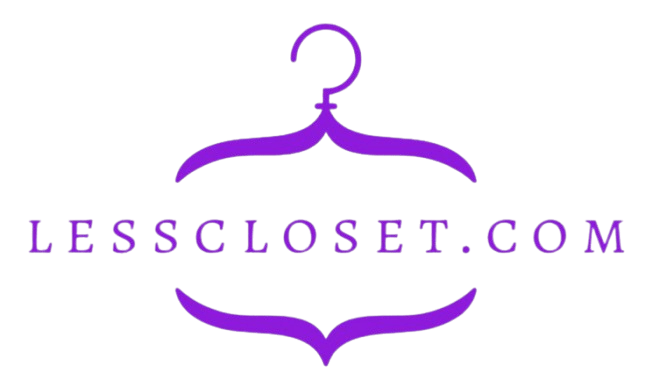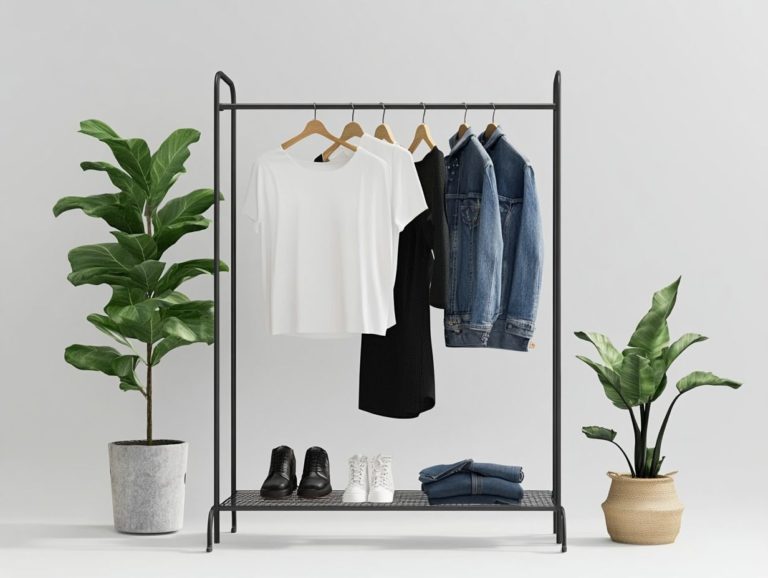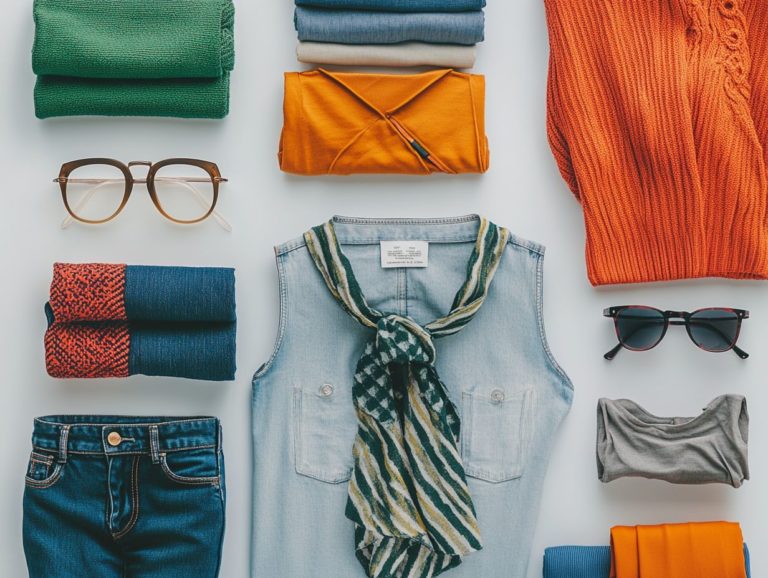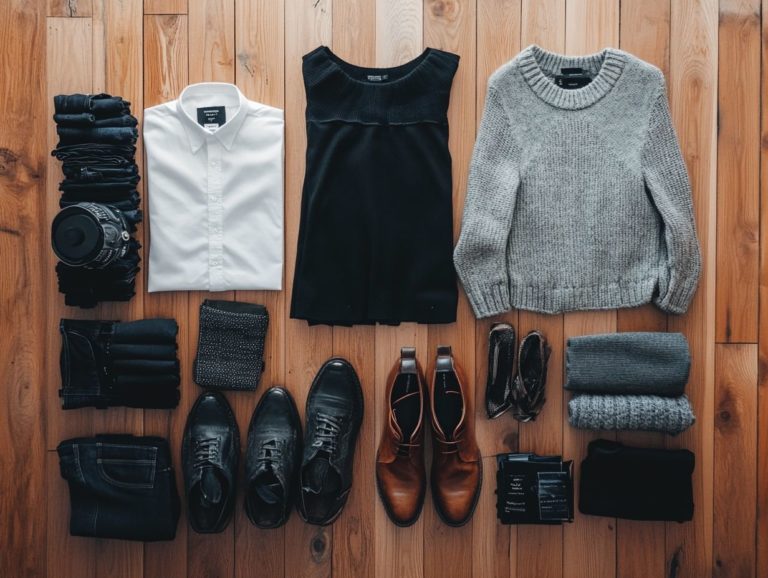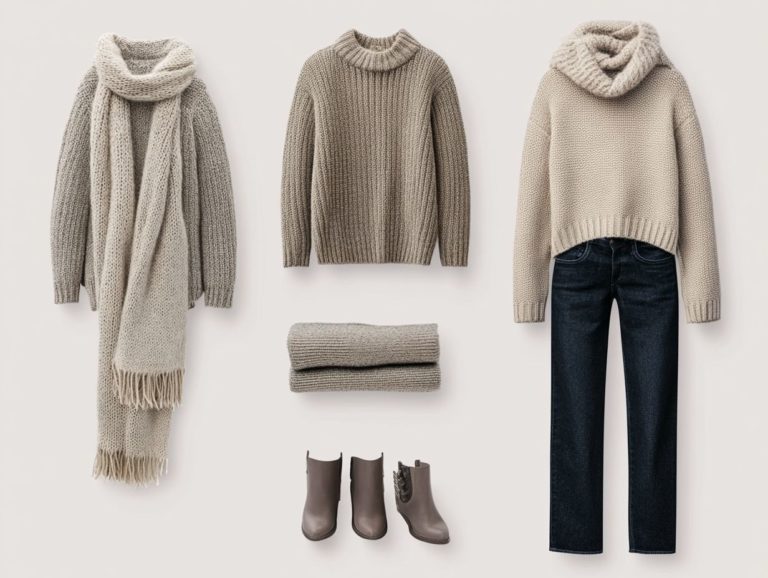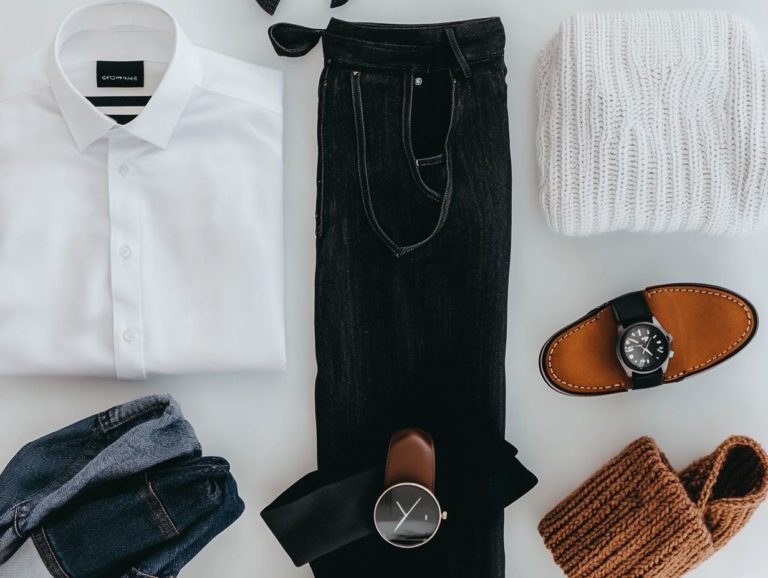Identifying Quality in Essential Clothing Items
In a world overflowing with fast fashion and fleeting trends, grasping the concept of essential clothing items can elevate your wardrobe into a curated collection of quality pieces that withstand the test of time.
This article reveals what distinguishes an item as truly essential. Key factors include fabric quality, fit, and versatility. You ll discover how to assess quality across various clothing types, from shirts and pants to jackets and accessories.
You ll find valuable tips on maintaining your favorite pieces, ensuring they remain stylish and durable for years ahead.
Jump in and revolutionize your wardrobe today!
Contents
- Key Takeaways:
- Understanding Essential Clothing Items
- Factors to Consider When Choosing Quality Clothing
- Identifying Quality in Different Types of Clothing
- Tips for Maintaining Quality Clothing
- Frequently Asked Questions
- What are some key factors to consider when identifying quality in essential clothing items?
- How does the material of a clothing item affect its quality?
- What are some signs of a high-quality clothing item?
- Why consider construction methods in clothing?
- How can I tell if a clothing item will last?
- What should I look for in the fit of clothing?
- Investing in Quality
Key Takeaways:

- Essential clothing items are versatile, timeless, and durable pieces that can be easily mixed and matched!
- When choosing quality clothing, consider factors such as fabric quality, fit and comfort, and versatility!
- Quality can be identified in different types of clothing through proper care and maintenance, as well as by paying attention to details such as fabric, stitching, and construction!
Understanding Essential Clothing Items
Essential clothing items serve as the cornerstone of your well-curated wardrobe. Here, high-quality garments effortlessly harmonize with a minimalist aesthetic, embodying both style and sustainability.
Selecting these pieces transcends superficial aesthetics; it engages with how brands are perceived and the environmental implications of fast fashion, which means cheap, trendy clothes that don’t last.
To build a wardrobe that looks good and feels good, you must reflect on the longevity of designer pieces and your dedication to sustainable shopping. This approach highlights the importance of investing in high-quality items that endure beyond fleeting trends.
What Makes an Item Essential?
An essential clothing item is characterized by natural fabrics, exquisite craftsmanship, and the ability to create a flattering silhouette that effortlessly blends comfort with style.
These attributes ensure durability and elevate the overall aesthetic, allowing you to transition seamlessly from casual outings to more formal occasions. Fabrics like cotton and linen, celebrated for their breatheability and soft touch, are vital in providing comfort, particularly in diverse climates.
When meticulous attention is given to craftsmanship, every seam, stitch, and finish contributes to an item s enduring quality, allowing it to weather the changing tides of fashion. Ultimately, it s this harmonious blend of elements that fosters a lasting wardrobe, where versatility and elegance coexist beautifully.
Factors to Consider When Choosing Quality Clothing
When selecting quality clothing, it is essential for you to focus on assessing quality and understanding the distinguishing characteristics that set quality items apart from fast-fashion alternatives.
Pay attention to elements such as comfort, style, longevity, and resistance, as well as the materials employed whether they are luxurious natural fibers like wool and silk or practical synthetic options.
These factors will guide you in making a worthwhile investment in your wardrobe.
Fabric Quality and Durability
When selecting clothing, the quality and durability of the fabric are crucial, as they significantly influence the longevity of each piece and its overall environmental impact.
By investing in high-quality materials, you can acquire garments that stand the test of time, ultimately reducing the need for frequent replacements and minimizing waste. Natural fabrics like cashmere and 100% organic cotton not only offer resilience but also provide a level of comfort that feels indulgent. These luxurious options are also eco-friendly, requiring fewer chemical treatments and supporting sustainable farming practices that contribute to a healthier planet.
When you choose garments crafted from such materials, you play a vital role in promoting responsible fashion trends and encouraging brands to focus on developing more sustainable options.
Fit and Comfort
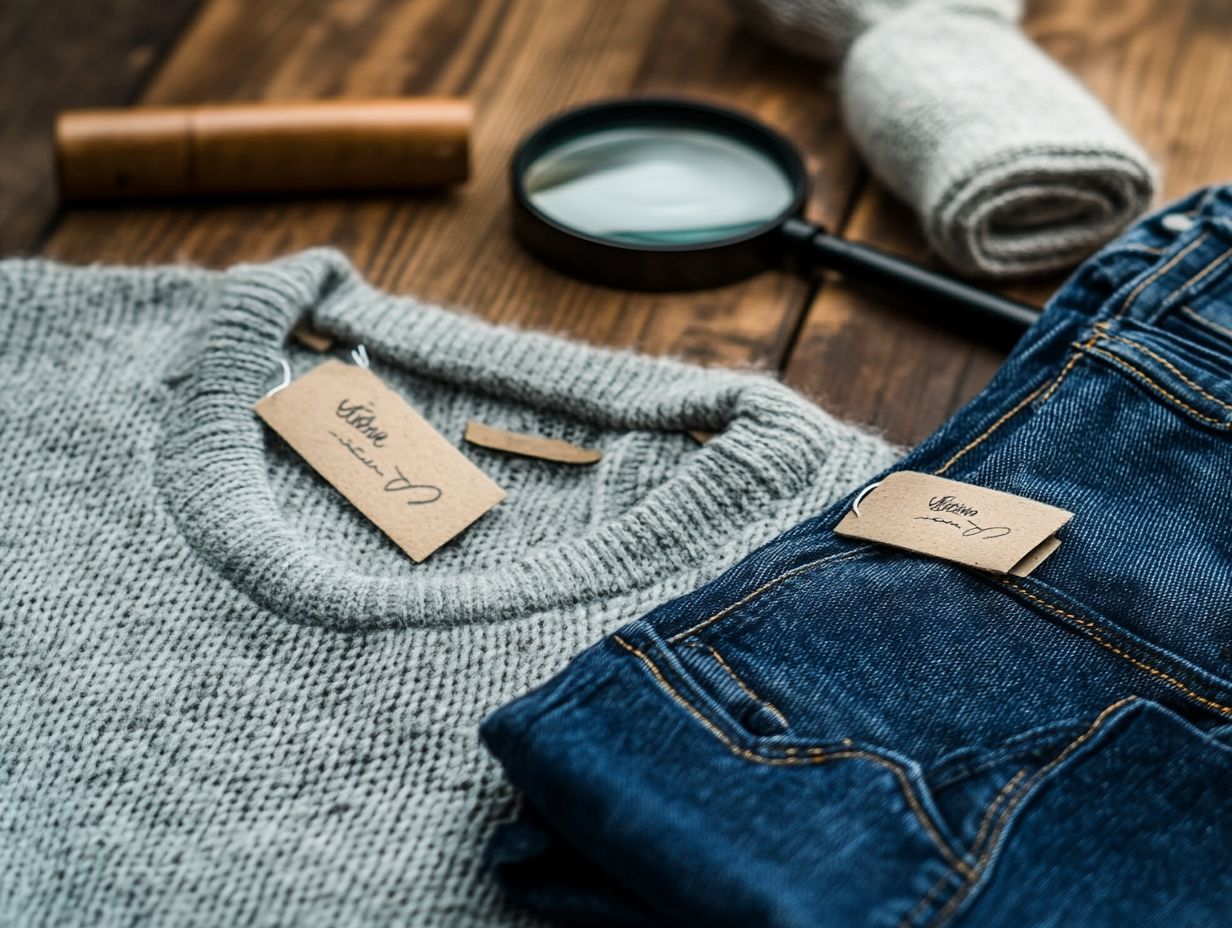
Fit and comfort are crucial when choosing clothing that flatters your silhouette and feels wonderful against your skin. This enhances your overall style.
As you consider a purchase, take the time to evaluate how well the garments accommodate your unique body shape. This assessment can greatly influence your satisfaction with the piece. Quality is key; clothing crafted from natural fabrics provides breathability, ease of movement, and a luxurious sensation against your skin. Additionally, opting for sustainable essential clothing items for minimalists can enhance your wardrobe while being mindful of the environment.
This careful selection helps you find wardrobe pieces that are both wearable and versatile, allowing you to express your personal style while ensuring comfort throughout your daily activities.
Versatility and Timelessness
Versatility and timelessness distinguish designer pieces from fast-fashion counterparts. These qualities ensure that your clothing retains its allure across seasons and enhances brand perception.
Act now! Choose garments that adapt to every occasion with style and are built to endure the test of time. Designer brands typically focus on higher-quality materials and craftsmanship, providing a longevity that fast fashion can seldom match. By investing in these pieces, you elevate your personal style while consciously opting to reduce waste and environmental impact. Discover the benefits of investing in essential clothing items for a more sustainable wardrobe.
This mindful shift fosters a more thoughtful approach to fashion, where quality triumphs over fleeting trends. Embrace this shift to make smarter fashion choices that are stylish and eco-friendly!
Identifying Quality in Different Types of Clothing
Identifying quality in various types of clothing requires a keen eye for detail and an understanding of essential characteristics that reflect a commitment to eco-friendly clothing. This discernment sets a higher standard, distinguishing premium garments from the fleeting allure of fast fashion.
Shirts and Tops
When evaluating shirts and tops, consider the materials at play everything from natural fabrics to synthetic options along with the flattering silhouettes they create and the careful construction involved.
Opting for high-quality materials not only enhances your comfort but also significantly impacts a garment s durability and overall aesthetic. For instance, organic cotton provides breathability and softness, making it a preferred choice among sustainable brands like Patagonia and Everlane, which emphasize eco-friendly practices in their production. On the flip side, blends like Tencel a soft fiber made from wood pulp known for its comfort and environmental benefits offer a luxurious feel while ensuring moisture-wicking properties, ideal for your active lifestyle.
Ethical companies often prioritize careful construction, ensuring every stitch and seam reflects their dedication to quality and sustainability. This attention to detail enhances style and appeals to you as a consumer seeking responsible fashion choices.
Pants and Bottoms
When choosing pants and bottoms, prioritize comfort and style, incorporating natural fibers to ensure longevity and durability while carefully assessing their overall quality.
The right fit can elevate even the simplest outfits, allowing you to move freely and confidently throughout your day. Comfort isn t just about how a garment feels at first wear; it also involves how it performs over time, especially with regular use. High-quality options typically feature reinforced seams, well-constructed waistbands, and superior materials that breathe better and stand up to daily wear.
These characteristics enhance your look and validate the investment you’ve made in quality, setting them apart from lower-quality alternatives that may fray or lose shape after just a few washes.
Outerwear and Jackets

Regarding outerwear and jackets, careful construction and the use of natural materials play a crucial role in determining their environmental impact and overall quality.
You can easily identify quality pieces by looking at the seams, lining, and the fabric’s weight. These details often speak volumes about the garment’s durability.
Sourcing materials like wool, cotton, or down not only elevates comfort but also offers essential insulation (the ability to keep you warm) for those brisk winds.
Check out the brand’s reputation. It often leads to designer pieces that are stylish and durable. Understanding these elements enables you to make informed choices that harmonize elegance with environmental awareness.
Accessories and Shoes
Accessories and shoes are essential components of high-quality clothing. They significantly enhance your overall style while shaping brand perception and comfort.
When you make thoughtful choices, these elements elevate your outfit to extraordinary levels. They reflect your unique taste and individuality.
Choose those standout shoes or accessories they can completely transform your look! By opting for high-quality, sustainable options in accessories and footwear, you embrace an eco-conscious lifestyle.
Selecting pieces designed to last keeps you looking chic and polished while helping reduce waste in the fashion industry.
Tips for Maintaining Quality Clothing
Maintaining quality clothing is crucial for ensuring its longevity and resilience. This journey begins with the right care practices and extends to timely repairs and alterations when needed. All of this is aimed at preserving your valuable investment.
Proper Care and Storage
Proper care and storage are essential for keeping your clothes looking great. This helps natural fabrics stay comfortable and stylish while minimizing their environmental impact.
By embracing best practices for washing, drying, and storing your garments, you can significantly extend the lifespan of your favorite pieces.
For delicate items, washing on a gentle cycle with cold water is key to minimizing wear and tear. This effectively preserves those precious fibers.
Opting for air drying is also wise; high heat can lead to shrinkage and degradation of natural materials, and nobody wants that.
Regarding storage, choosing breathable garment bags and avoiding overcrowded closets will help prevent unwanted creases and mildew. Adopting these mindful habits not only protects your cherished clothing but also promotes a more sustainable approach to fashion.
Repair and Alteration
Repair and alteration are essential components of maintaining the quality of your clothing. They enable you to preserve detailed craftsmanship while demonstrating a commitment to sustainable shopping.
When your garments start to show signs of wear think frayed hems or loose buttons taking prompt action can dramatically extend their lifespan.
Recognizing when to seek alterations is vital; if an outfit feels uncomfortably tight or too loose, that s your cue to call in a tailor.
To achieve that perfect fit, consider tweaking elements like sleeve lengths, waistbands, or the fit of your pants. Simple repairs, such as patching small holes or reinforcing seams, can remarkably enhance the durability of your garments.
By prioritizing these adjustments, you not only save money but also cultivate a personalized wardrobe that endures the test of time.
Frequently Asked Questions
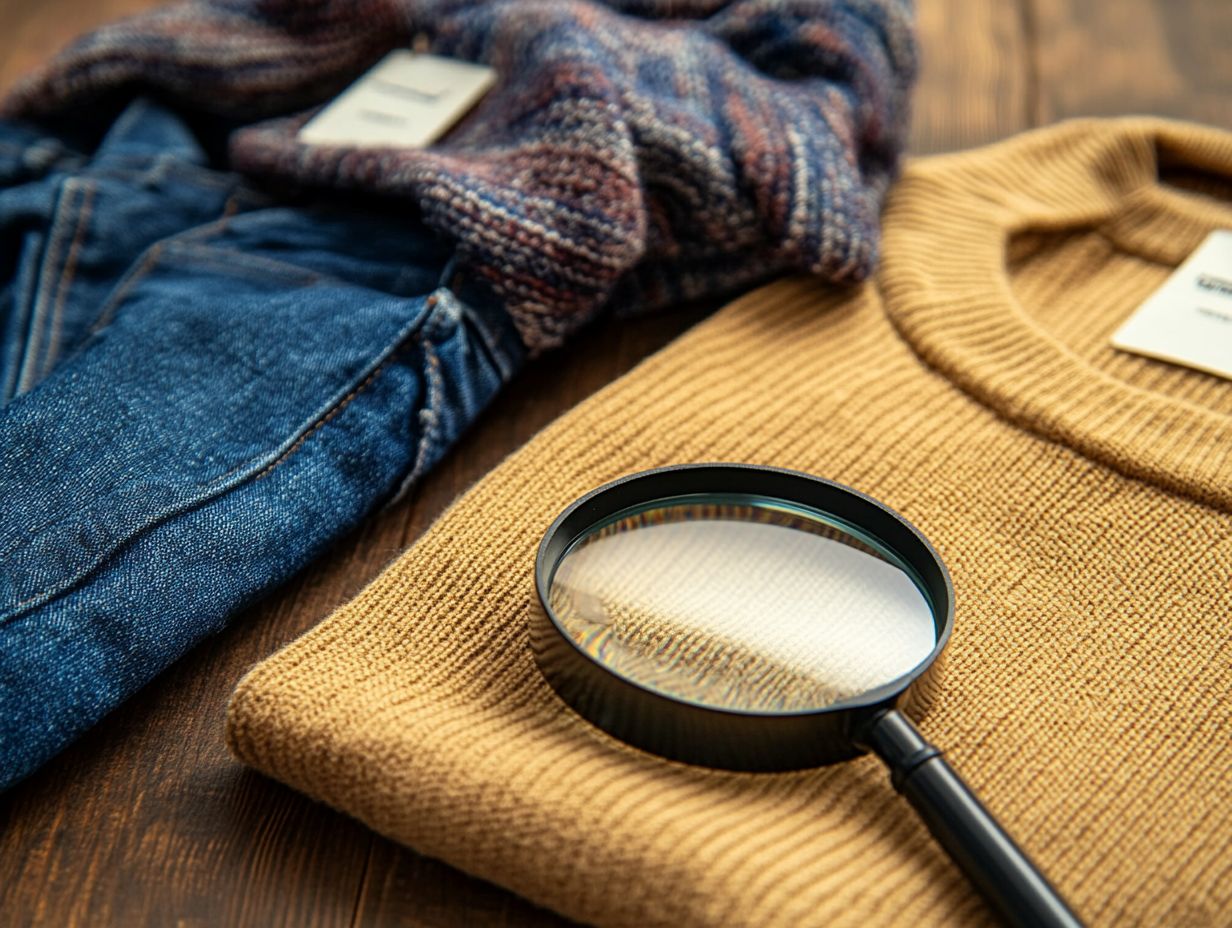
What are some key factors to consider when identifying quality in essential clothing items?
Some key factors to consider include the materials used, construction methods, durability, and fit of the clothing item.
How does the material of a clothing item affect its quality?
The material used in clothing greatly affects its quality. High-quality materials like cotton, silk, and wool last longer and feel more comfortable than cheaper, synthetic options.
What are some signs of a high-quality clothing item?
Look for strong, even stitching and smooth seams. A substantial weight and texture also indicate a well-made piece.
Why consider construction methods in clothing?
Construction methods impact durability. Quality techniques, like reinforced seams, help clothing resist wear and tear.
How can I tell if a clothing item will last?
Check the quality of materials and construction. Reviews from previous customers can also provide valuable insight.
What should I look for in the fit of clothing?
A well-fitting piece should feel comfortable and allow for easy movement. It should hug your body just right, neither too tight nor too loose.
Investing in Quality
Invest in quality clothing today for a wardrobe that lasts!
